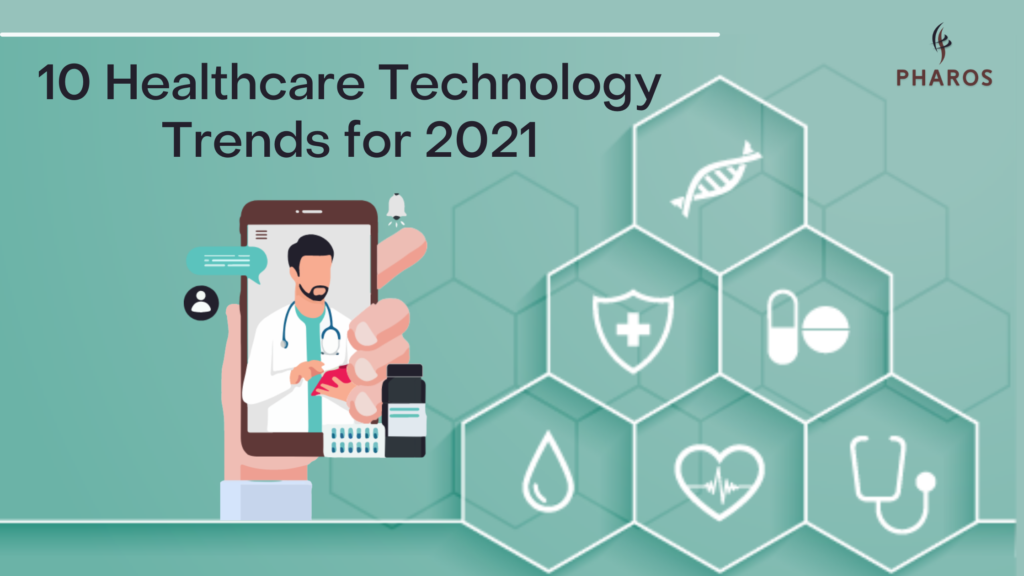
Technology evolution for intelligent healthcare saves the day. The world has witnessed a global pandemic since a year of inception and several lives were lost. At the same time, technology continues to help improve healthcare treatments and save affected lives too.
Be Covid-19 testing, telemedicine, vaccination or genetic analysis, technology has paved the way for greater understanding of virulence & its impact. In the following, we touch upon the top healthcare technology trends 2021 that marks critical real-time diagnosis, disease treatment and management, preventive measures, and accurate medical solutions.
1-Internet of Medical Things
No, there’s no aberration when we discuss the Internet of Medical Things (IoMT). Innovations in telehealth services with telemedicine tremendously empowers IoT development using Smart appliances like Smart Medication Dispensers, ECG monitoring, and EKG monitors. Medical monitoring highlights the pivotal function in pre-diagnostics, timely treatment, and preventive care.
When the surge of patients hustling to find a bed in the hospital during this pandemic became overwhelming, home-based monitoring came to rescue. IoMT is a glorious example of this necessity.
2-Big Data and Predictive Analytics
Big data distinctively changes the discourse of actions in today’s world. In healthcare, advanced database technologies, medical analytics, and top-notch analytics derive cumulative and reliable information. Key data from diagnosis, medical imaging, and medical records, collated and arranged, give substantial validation for preventive measures and healthcare treatment.
Big Data and Predictive Analytics enables the resources and tools in the approach to find various temporary and permanent cures for diseases.
3-MR/AR/VR in Healthcare
Augmented Reality (AR), Virtual Reality (VR), and Mixed Reality (MR) have proven effective technologies in pain management, surgeries, phobia management, PTSD, and meditation. Patient examination and medical practice using HoloLens may soon become a reality.
Evolving technologies of MR/AR/VR are likely to reduce patient anxiety, stress, and ignorance concerning health. Though medical practitioners face difficulties in convincing patients, cumulative efforts from relatives and professionals help a lot.
4-Telemedicine
The global telemedicine market grows outrageously with the increase of chronic diseases in people. Be it diabetes, heart disease, cancer, life-style associated, or even Covid-19, telemedicine has proven helpful in treating patients at a far off location. However, certain middle and low income countries face issues with the implementation of telemedicine due to high installation costs and technological barriers.
The future for telemedicine isn’t bleak though. Countries zooming in to help the global cause for health & security gradually focus to pull out people from these longstanding obstacles too.
5-3D Printing Technology
Every patient has a different case and complexities. Medical practitioners and surgeons can utilize the latest accessible technology of 3D printing to individually attend complex cases with precision and personalized approach. 3D printing in healthcare has provided innovative tools for providing high-quality care to the patients.
Patient-specific surgical models using 3D printing have helped surgeons to prepare better for surgeries on patients and reduce the latter’s stress, anxiety, and related issues. Other innovative use cases include new medical devices and instruments at affordable prices, prostheses, corrective insoles and orthoses, 3D printed organs, bioprinting, and tissue engineering.
6-Healthcare Wearable and Sensors
People wear fitness trackers these days to monitor their heart rate, pulse, and blood pressure. Smart wearable technology in sync with Smartphone Apps allows physiological and biochemical monitoring, which further helps in improving patient care and reducing costs.
Data analysis algorithms and advanced wearable technology with sensors have a potential to bring down the lifestyle-associated risks in the future.
7-Blockchain Technology
Healthcare applications of blockchain technology enables reliable transfer of patient medical records, sustains the medical supply chain, and guides researchers to unlock genetic code. Sensitivity of medical data largely accumulates focus for data breaches, but the decentralized nature of blockchain with strict compliance of established rules reduce or eliminate any doubts.
8-Artificial Intelligence in Healthcare
While Artificial Intelligence (AI) is dreaded upon in different parts of the world, the healthcare industry is set to gain a transformative impact by providing solutions to the most complex medical problems. AI and machine learning, with their complex algorithms, have enabled superior clinical trials, medical diagnosis, drug discovery, pain management, and improving patient outcomes.
9-Nanotechnology
The efficacy of drug delivery and treatment using nanotechnology goes higher up in the healthcare industry. Protecting human lives using nanoparticles to treat cancerous tumors is a feat that scientists have achieved so far. Likewise, escalating DNA sequencing, tissue regeneration, and wound treatment comes under the responsible development of nanotechnology.
10-Cloud Computing
With several businesses switching to cloud computing for good, the healthcare sector too has benefited from easy record-sharing, automated scaling, reduced EHR latency, streamlined data management, and billing operations.
We expect a large base of healthcare units transitioning to cloud computing in 2021 and coming years. Not only will it help with networking at low costs, but improve healthcare efficiency, quick response times to challenges, and practice management.
CONCLUSION
Healthcare technology trends 2021 highlights how technology and people can together improve the lives of patients through appropriate care without delays, inaccuracies, and dysfunctional data. Utilization of technology to help humankind is the best activity in the whole world that healthcare providers continue to do.